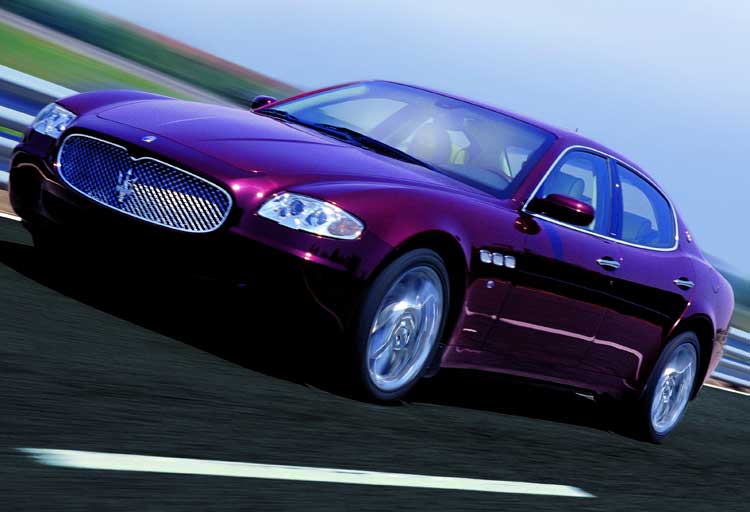Maserati Quattroporte
Martin Buckley celebrates the Sixties supercar that had style and speed to take the breath away

To those steeped in the mythology of the Sixties supercar, the Maserati Quattroporte cuts an enigmatic figure. Swift, discreet and multi-cammed, it was a car built to appeal to grown-ups, not schoolboys.
Its quiet four-door styling turned only the heads its rich owners wanted to turn, yet under the sober hand-tailored exterior - cut sharp and simple like a Milan businessman's suit - the hard V8, quad-cam muscle still remained.
Throughout the Sixties, it held the title of the fastest four-door four-seater on the planet, topping 130mph in leather-lined opulence. It was a cool, cool thing, the big QP, a car for the chosen few that went a step beyond the usual glitzy motoring status symbols of the time. There were other four-door Italian super saloons (from the likes of ISO and De Tomaso) but these seemed like trinkets, shallow pretenders, in the presence of the Quattroporte.
Announced with square lights and 4.2-litre V8 engine, manual or automatic transmission and DeDion rear suspension in 1963, the more familiar variant is the post-1965 model with quad circular lights and conventional beam rear axle. Inside, its dashboard was revised and a bigger 4.7 offered optionally. Actually, "familiar" is a relative term: only 759 QPs of all types were built through to 1969. Famous Quattroporte owners include Pavarotti, Peter Ustinov and Lawrence Harvey, who drove it on screen in Life At The Top.
The four-door Maserati concept faltered at this point. The Bertone-styled Quattroporte II - based on a Citroën SM - was killed off after only five had been made in the mid-Seventies, but the name resurfaced in 1978 with the slightly gross Quattroporte III. Built, like the wedge Aston Martin Lagonda, to appeal to Arab markets, most seem to have been finished in white, with white leather. If you can live with the image, they can come supercheap and go very well with a 4.9-litre V8.
The Quattroporte IV of the mid-Nineties looked the part but suffered too many hangovers from the Bi-Turbo wilderness years.
What was needed was a QP that could recapture the glamour of the Sixties original. Enter, in 2003, an entirely new Quattroporte built with Fiat money and Ferrari know-how. Here was sophistication and restrained elegance, and in a 170mph super saloon that gave nothing away to its fat Teutonic rivals.
Without descending into pastiche, the essence of the original car had been captured, and many would say the new Quattroporte is about the coolest, most fashionable car in the world in 2005.
However, if you can't stretch to £75,000, you can look even cooler in the Sixties version. As with so many of the unloved four-door progeny of apparently more exciting two-door machinery, today the 1963-69 Maserati Quattroporte - one of the most expensive cars on the planet in its day - now represents truly exotic Sixties motoring in its cheapest form. You could own a really fine Quattroporte - essentially a Ghibli in a sober suit, don't forget - for about 10 to 15 grand.
In profile, the Frua styling had dignity and presence, the sculptured nose an air of the exotic. Thin pillars and a tall roof allow lots of glass area, while the long, brutally chopped-off tail promised a massive 20.7 cubic feet load area for that long-haul trip to the Riviera.
The interior of the Quattroporte was light and airy, supple leather, dark beech wood and lots of chrome combining to give a feeling of upmarket international good taste. The detailing was wonderful, with delicately calibrated white-on-black seven-dial instrumentation crowded into the binnacle, and an impressive bank of toggle switches across the dash.
Even the chromed vent grilles looked substantial and well wrought. The wooden steering wheel was smooth and cool to the touch, complementing a wonderfully commanding driving position that gave a perfect view through the huge screen across the bonnet and wings, and allowed anybody - from Lawrence Harvey to Ustinov - an ideal posture for manipulation of the high-set, wooden-topped gear lever and big, beefy foot pedals.
Powered by a four-camshaft, all-alloy V8 engine, derived directly from the 450S sports racing car, the Quattroporte was fabulously powerful by the standards of 1963. Third was good for 90, fourth 110 and in top a healthy Quattroporte would pull more than 130mph when taken to its 5,500rpm red line, a deep, rich, high-class crescendo of chain thrash, cam whine and gobbling carburettors. In reality, you could make swift, seamless progress, using a narrow band of revs between 2,500 and 4,000, with only fourth and top. The Quattroporte was also perfectly well mannered and flexible at low speeds.
Compared with other ordinary luxury saloons, the Maserati didn't exactly top the sales charts, but that was hardly the point of such a discreet, swift and subtle hand-built motorcar: the merely wealthy would always be content with their Rolls Royces, Mercedes and Cadillacs, but only the cognoscenti had the taste to choose a Quattroporte.
Join our commenting forum
Join thought-provoking conversations, follow other Independent readers and see their replies
Comments
Bookmark popover
Removed from bookmarks